EzVPN with NEM on IOS Router with VPN 3000 Concentrator Configuration Example
Available Languages
Contents
Introduction
This document explains the procedure you use in order to configure a Cisco IOS® router as an EzVPN in Network Extension Mode (NEM) to connect to a Cisco VPN 3000 Concentrator. A new EzVPN Phase II feature is the support of a basic Network Address Translation (NAT) configuration. The EzVPN Phase II is derived from the Unity Protocol (VPN Client software). The remote device is always the initiator of the IPsec tunnel. However, Internet Key Exchange (IKE) and IPsec proposals are not configurable on the EzVPN Client. The VPN Client negotiates proposals with the server.
In order to configure IPsec between a PIX/ASA 7.x and a Cisco 871 router using Easy VPN, refer to PIX/ASA 7.x Easy VPN with an ASA 5500 as the Server and Cisco 871 as the Easy VPN Remote Configuration Example.
In order to configure IPsec between the Cisco IOS® Easy VPN Remote Hardware Client and the PIX Easy VPN Server, refer to IOS Easy VPN Remote Hardware Client to a PIX Easy VPN Server Configuration Example.
In order to configure a Cisco 7200 Router as an EzVPN and the Cisco 871 Router as the Easy VPN Remote, refer to 7200 Easy VPN Server to 871 Easy VPN Remote Configuration Example.
Prerequisites
Requirements
Before you attempt this configuration check that the Cisco IOS router supports the EzVPN Phase II feature and has the IP connectivity with end-to-end connections to establish the IPsec tunnel.
Components Used
The information in this document is based on these software and hardware versions:
-
Cisco IOS Software Release 12.2(8)YJ (EzVPN Phase II)
-
VPN 3000 Concentrator 3.6.x
-
Cisco 1700 Router
The information in this document was created from the devices in a specific lab environment. All of the devices used in this document started with a cleared (default) configuration. If your network is live, make sure that you understand the potential impact of any command.
Note: This configuration was recently tested with a Cisco 3640 Router with Cisco IOS Software Release 12.4(8) and the VPN 3000 Concentrator 4.7.x version.
Conventions
Refer to Cisco Technical Tips Conventions for more information on document conventions.
Configure the VPN 3000 Concentrator
Task
In this section, you are presented with the information to configure the VPN 3000 Concentrator.
Network Diagram
This document uses the network setup shown in this diagram. Loopback interfaces are used as internal subnets, and FastEthernet 0 is the default to the Internet.
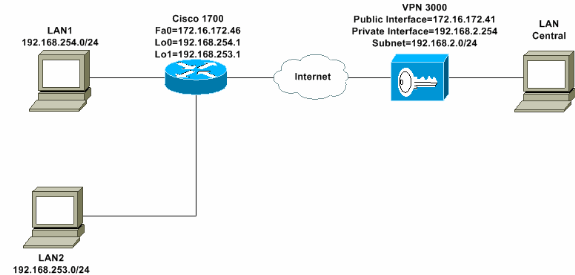
Step by Step Instructions
Complete these steps:
-
Choose Configuration > User Management > Groups > Add and define a group name and password in order to configure an IPsec group for the users.
This example uses the group name turaro with password/verify tululo.
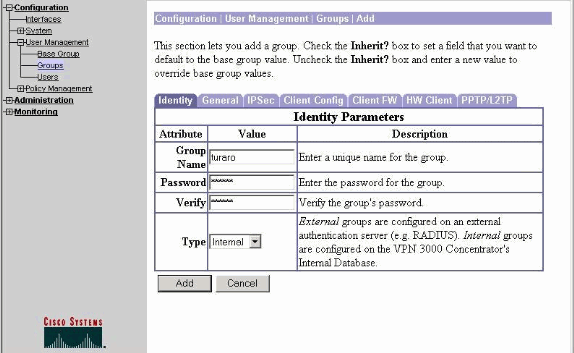
-
Choose Configuration > User Management > Groups > turaro > General to enable IPSec and disable Point-to-Point Tunneling Protocol (PPTP) and Layer 2 Tunnel Protocol (L2TP).
Make your selections and click Apply.
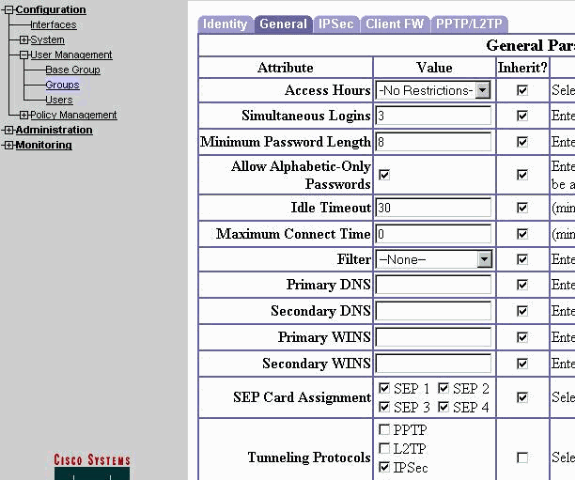
-
Set Authentication to Internal for Extended Authentication (Xauth) and ensure that the Tunnel Type is Remote Access and the IPSec SA is ESP-3DES-MD5.
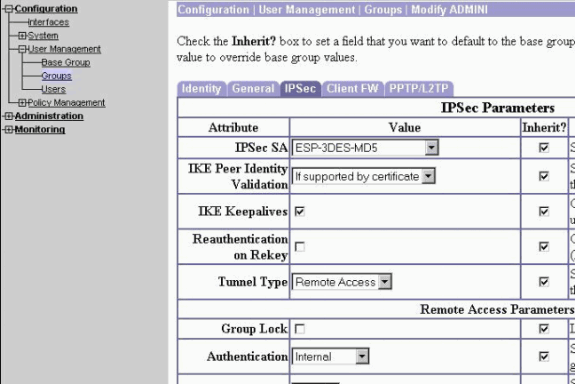
-
Choose Configuration > System > Tunneling Protocols > IPSec > IKE Proposals in order to make sure that the Cisco VPN Client (CiscoVPNClient-3DES-MD5) is in Active Proposals for IKE (Phase 1).
Note: From VPN Concentrator 4.1.x, the procedure is different for ensuring that the Cisco VPN Client is in the list of Active Proposals for IKE (phase 1). Choose Configuration > Tunneling and Security > IPSec > IKE Proposals.
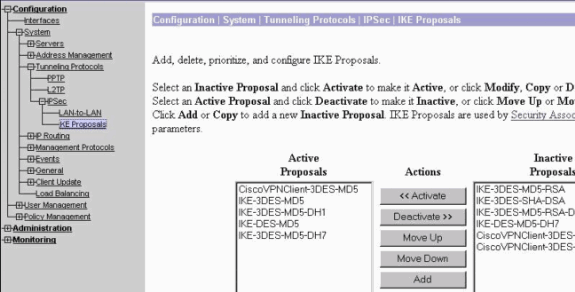
-
Verify your IPsec Security Association (SA).
On step 3 your IPsec SA is ESP-3DES-MD5. You can create a new one if you wish but make sure you use the correct IPsec SA on your group. You should disable Perfect Forward Secrecy (PFS) for the IPsec SA that you use. Select the Cisco VPN Client as the IKE proposal by choosing Configuration > Policy Management > Traffic Management > SAs. Type the SA name in the text box and make the appropriate selections as shown here:
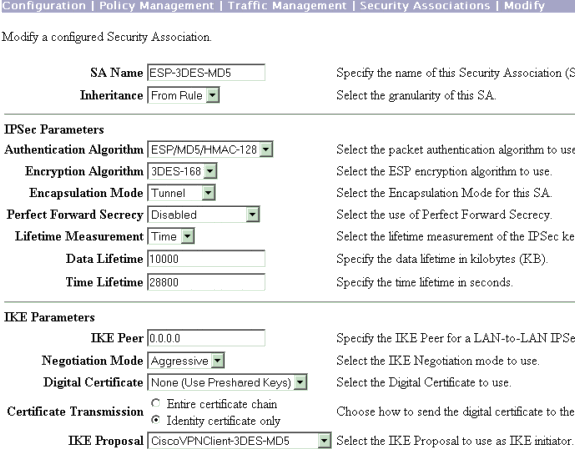
Note: This step and the next step are optional if you prefer to choose a pre-defined SA. If your client has a dynamically assigned IP address, use 0.0.0.0 in the IKE peer text box. Make ensure that IKE Proposal is set to CiscoVPNClient-3DES-MD5 as this example shows.
-
You must not click Allow the networks in the list to bypass the tunnel. The reason is that split tunneling is supported, but the bypass feature is not supported with the EzVPN Client feature.
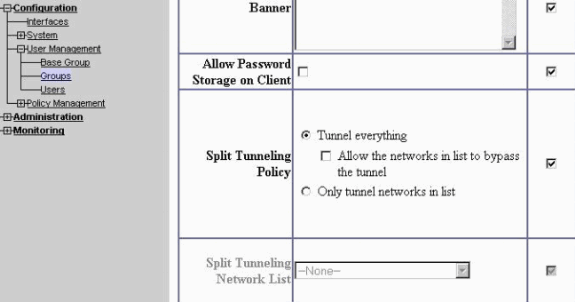
-
Choose Configuration > User Management > Users in order to add a user. Define a user name and password, assign it to a group, and click Add.
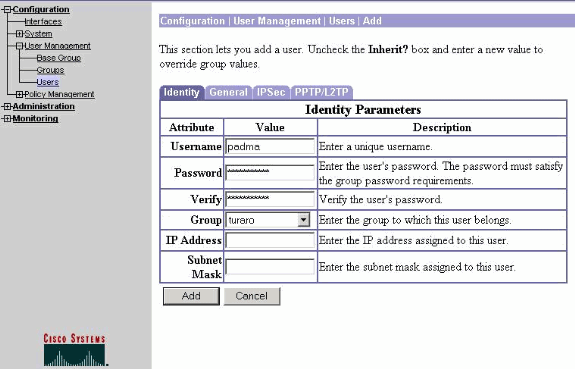
-
Choose Administration > Admin Sessions and check that the user is connected. In NEM, the VPN Concentrator does not assign an IP address from the pool.
Note: This step is optional if you prefer to choose a predefined SA.
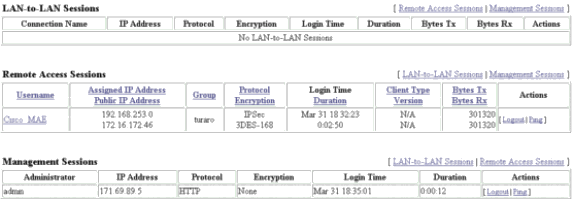
-
Click either the Save Needed or Save icon in order to save the configuration.
Router Configuration
show version Output
show version Cisco Internetwork Operating System Software IOS (tm) C1700 Software (C1700-BK9NO3R2SY7-M), Version 12.2(8)YJ, EARLY DEPLOYMENT RELEASE SOFTWARE (fc1) 1721-1(ADSL) uptime is 4 days, 5 hours, 33 minutes System returned to ROM by reload System image file is "flash:c1700-bk9no3r2sy7-mz.122-8.YJ.bin" cisco 1721 (MPC860P) processor (revision 0x100) with 88474K/9830K bytes 16384K bytes of processor board System flash (Read/Write)
| 1721-1 |
|---|
1721-1(ADSL)#show run version 12.2 service timestamps debug uptime service timestamps log uptime no service password-encryption ! hostname 1721-1(ADSL) ! !--- Specify the configuration name !--- to be assigned to the interface. crypto ipsec client ezvpn SJVPN !--- Tunnel control; automatic is the default. connect auto !--- The group name and password should be the same as given in the VPN Concentrator. group turaro key tululo !--- The mode that is chosen as the network extension. mode network-extension !--- The tunnel peer end (VPN Concentrator public interface IP address). peer 172.16.172.41 ! interface Loopback0 ip address 192.168.254.1 255.255.255.0 !--- Configure the Loopback interface !--- as the inside interface. ip nat inside !--- Specifies the Cisco EzVPN Remote configuration name !--- to be assigned to the inside interface. crypto ipsec client ezvpn SJVPN inside ! interface Loopback1 ip address 192.168.253.1 255.255.255.0 ip nat inside crypto ipsec client ezvpn SJVPN inside ! interface FastEthernet0 ip address 172.16.172.46 255.255.255.240 !--- Configure the FastEthernet interface !--- as the outside interface. ip nat outside !--- Specifies the Cisco EzVPN Remote configuration name !--- to be assigned to the first outside interface, because !--- outside is not specified for the interface. !--- The default is outside. crypto ipsec client ezvpn SJVPN ! !--- Specify the overload option with the ip nat command !--- in global configuration mode in order to enable !--- Network Address Translation (NAT) of the inside source address !--- so that multiple PCs can use the single IP address. ip nat inside source route-map EZVPN interface FastEthernet0 overload ip classless ip route 0.0.0.0 0.0.0.0 172.16.172.41 ! access-list 177 deny ip 192.168.254.0 0.0.0.255 192.168.2.0 0.0.0.255 access-list 177 deny ip 192.168.253.0 0.0.0.255 192.168.2.0 0.0.0.255 access-list 177 permit ip 192.168.253.0 0.0.0.255 any access-list 177 permit ip 192.168.254.0 0.0.0.255 any ! route-map EZVPN permit 10 match ip address 177 ! ! line con 0 line aux 0 line vty 0 4 password cisco login ! no scheduler allocate end |
Verify
Use this section to confirm that your configuration works properly.
The Output Interpreter Tool (registered customers only) (OIT) supports certain show commands. Use the OIT to view an analysis of show command output.
Once you configure both devices, the Cisco 3640 router attempts to set up the VPN tunnel by contacting the VPN Concentrator automatically using the peer IP address. After the initial ISAKMP parameters are exchanged, the router displays this message:
Pending XAuth Request, Please enter the following command: crypto ipsec client ezvpn xauth
You have to enter the crypto ipsec client ezvpn xauth command which prompts you for a username and password. This should match the username and password configured on the VPN Concentrator (step 7). Once the username and password are agreed by both peers, the rest of the parameters are agreed and the IPsec VPN tunnel comes up.
EZVPN(SJVPN): Pending XAuth Request, Please enter the following command: EZVPN: crypto ipsec client ezvpn xauth !--- Enter the crypto ipsec client ezvpn xauth command. crypto ipsec client ezvpn xauth Enter Username and Password.: padma Password: : password
Troubleshoot
This section provides information you can use to troubleshoot your configuration.
Troubleshooting Commands
Certain show commands are supported by the Output Interpreter Tool (registered customers only) , which allows you to view an analysis of show command output.
Note: Refer to Important Information on Debug Commands before you issue debug commands.
-
debug crypto ipsec client ezvpn—Displays information that shows the configuration and implementation of the EzVPN Client feature.
-
debug crypto ipsec—Displays debug information about IPsec connections.
-
debug crypto isakmp—Displays debug information about IPsec connections, and shows the first set of attributes that are denied due to incompatibilities on both ends.
-
show debug—Displays the state of each debugging option.
Output from Debug Commands
As soon as you enter the crypto ipsec client ezvpn SJVPN command, the EzVPN Client attempts to connect to the server. If you change the connect manual command under the group configuration, enter the crypto ipsec client ezvpn connect SJVPN command to initiate the exchange of proposals to the server.
4d05h: ISAKMP (0:3): beginning Aggressive Mode exchange
4d05h: ISAKMP (0:3): sending packet to 172.16.172.41 (I) AG_INIT_EXCH
4d05h: ISAKMP (0:3): received packet from 172.16.172.41 (I) AG_INIT_EXCH
4d05h: ISAKMP (0:3): processing SA payload. message ID = 0
4d05h: ISAKMP (0:3): processing ID payload. message ID = 0
4d05h: ISAKMP (0:3): processing vendor id payload
4d05h: ISAKMP (0:3): vendor ID is Unity
4d05h: ISAKMP (0:3): processing vendor id payload
4d05h: ISAKMP (0:3): vendor ID seems Unity/DPD but bad major
4d05h: ISAKMP (0:3): vendor ID is XAUTH
4d05h: ISAKMP (0:3): processing vendor id payload
4d05h: ISAKMP (0:3): vendor ID is DPD
4d05h: ISAKMP (0:3) local preshared key found
4d05h: ISAKMP (0:3) Authentication by xauth preshared
4d05h: ISAKMP (0:3): Checking ISAKMP transform 6 against priority 65527 policy
4d05h: ISAKMP: encryption 3DES-CBC
4d05h: ISAKMP: hash MD5
4d05h: ISAKMP: default group 2
4d05h: ISAKMP: auth XAUTHInitPreShared
4d05h: ISAKMP: life type in seconds
4d05h: ISAKMP: life duration (VPI) of 0x0 0x20 0xC4 0x9B
4d05h: ISAKMP (0:3): Encryption algorithm offered does not match policy!
4d05h: ISAKMP (0:3): atts are not acceptable. Next payload is 0
4d05h: ISAKMP (0:3): Checking ISAKMP transform 6 against priority 65528 policy
4d05h: ISAKMP: encryption 3DES-CBC
4d05h: ISAKMP: hash MD5
4d05h: ISAKMP: default group 2
4d05h: ISAKMP: auth XAUTHInitPreShared
4d05h: ISAKMP: life type in seconds
4d05h: ISAKMP: life duration (VPI) of 0x0 0x20 0xC4 0x9B
4d05h: ISAKMP (0:3): Encryption algorithm offered does not match policy!
4d05h: ISAKMP (0:3): atts are not acceptable. Next payload is 0
4d05h: ISAKMP (0:3): Checking ISAKMP transform 6 against priority 65529 policy
4d05h: ISAKMP: encryption 3DES-CBC
4d05h: ISAKMP: hash MD5
4d05h: ISAKMP: default group 2
4d05h: ISAKMP: auth XAUTHInitPreShared
4d05h: ISAKMP: life type in seconds
4d05h: ISAKMP: life duration (VPI) of 0x0 0x20 0xC4 0x9B
4d05h: ISAKMP (0:3): Encryption algorithm offered does not match policy!
4d05h: ISAKMP (0:3): atts are not acceptable. Next payload is 0
4d05h: ISAKMP (0:3): Checking ISAKMP transform 6 against priority 65530 policy
4d05h: ISAKMP: encryption 3DES-CBC
4d05h: ISAKMP: hash MD5
4d05h: ISAKMP: default group 2
4d05h: ISAKMP: auth XAUTHInitPreShared
4d05h: ISAKMP: life type in seconds
4d05h: ISAKMP: life duration (VPI) of 0x0 0x20 0xC4 0x9B
4d05h: ISAKMP (0:3): Encryption algorithm offered does not match policy!
4d05h: ISAKMP (0:3): atts are not acceptable. Next payload is 0
4d05h: ISAKMP (0:3): Checking ISAKMP transform 6 against priority 65531 policy
4d05h: ISAKMP: encryption 3DES-CBC
4d05h: ISAKMP: hash MD5
4d05h: ISAKMP: default group 2
4d05h: ISAKMP: auth XAUTHInitPreShared
4d05h: ISAKMP: life type in seconds
4d05h: ISAKMP: life duration (VPI) of 0x0 0x20 0xC4 0x9B
4d05h: ISAKMP (0:3): Hash algorithm offered does not match policy!
4d05h: ISAKMP (0:3): atts are not acceptable. Next payload is 0
4d05h: ISAKMP (0:3): Checking ISAKMP transform 6 against priority 65532 policy
4d05h: ISAKMP: encryption 3DES-CBC
4d05h: ISAKMP: hash MD5
4d05h: ISAKMP: default group 2
4d05h: ISAKMP: auth XAUTHInitPreShared
4d05h: ISAKMP: life type in seconds
4d05h: ISAKMP: life duration (VPI) of 0x0 0x20 0xC4 0x9B
4d05h: ISAKMP (0:3): atts are acceptable. Next payload is 0
4d05h: ISAKMP (0:3): processing KE payload. message ID = 0
4d05h: ISAKMP (0:3): processing NONCE payload. message ID = 0
4d05h: ISAKMP (0:3): SKEYID state generated
4d05h: ISAKMP (0:3): processing HASH payload. message ID = 0
4d05h: ISAKMP (0:3): SA has been authenticated with 172.16.172.41
4d05h: ISAKMP (0:3): sending packet to 172.16.172.41 (I) AG_INIT_EXCH
4d05h: ISAKMP (0:3): Input = IKE_MESG_FROM_PEER, IKE_AM_EXCH
Old State = IKE_I_AM1 New State = IKE_P1_COMPLETE
4d05h: IPSEC(key_engine): got a queue event...
4d05h: IPSec: Key engine got KEYENG_IKMP_MORE_SAS message
4d05h: ISAKMP (0:3): Need XAUTH
4d05h: ISAKMP (0:3): Input = IKE_MESG_INTERNAL, IKE_PHASE1_COMPLETE
Old State = IKE_P1_COMPLETE New State = IKE_P1_COMPLETE
!--- Phase 1 (ISAKMP) is complete.
4d05h: ISAKMP: received ke message (6/1)
4d05h: ISAKMP: received KEYENG_IKMP_MORE_SAS message
4d05h: ISAKMP: set new node -857862190 to CONF_XAUTH
!--- Initiate extended authentication.
4d05h: ISAKMP (0:3): sending packet to 172.16.172.41 (I) CONF_XAUTH
4d05h: ISAKMP (0:3): purging node -857862190
4d05h: ISAKMP (0:3): Sending initial contact.
4d05h: ISAKMP (0:3): received packet from 172.16.172.41 (I) CONF_XAUTH
4d05h: ISAKMP: set new node -1898481791 to CONF_XAUTH
4d05h: ISAKMP (0:3): processing transaction payload from
172.16.172.41. message ID = -1898481791
4d05h: ISAKMP: Config payload REQUEST
4d05h: ISAKMP (0:3): checking request:
4d05h: ISAKMP: XAUTH_TYPE_V2
4d05h: ISAKMP: XAUTH_USER_NAME_V2
4d05h: ISAKMP: XAUTH_USER_PASSWORD_V2
4d05h: ISAKMP: XAUTH_MESSAGE_V2
4d05h: ISAKMP (0:3): Xauth process request
4d05h: ISAKMP (0:3): Input = IKE_MESG_FROM_PEER, IKE_CFG_REQUEST
Old State = IKE_P1_COMPLETE New State = IKE_XAUTH_REPLY_AWAIT
4d05h: EZVPN(SJVPN): Current State: READY
4d05h: EZVPN(SJVPN): Event: XAUTH_REQUEST
4d05h: EZVPN(SJVPN): ezvpn_xauth_request
4d05h: EZVPN(SJVPN): ezvpn_parse_xauth_msg
4d05h: EZVPN: Attributes sent in xauth request message:
4d05h: XAUTH_TYPE_V2(SJVPN): 0
4d05h: XAUTH_USER_NAME_V2(SJVPN):
4d05h: XAUTH_USER_PASSWORD_V2(SJVPN):
4d05h: XAUTH_MESSAGE_V2(SJVPN) <Enter Username and Password.>
4d05h: EZVPN(SJVPN): New State: XAUTH_REQ
4d05h: ISAKMP (0:3): Input = IKE_MESG_INTERNAL, IKE_PHASE1_COMPLETE
Old State = IKE_XAUTH_REPLY_AWAIT New State = IKE_XAUTH_REPLY_AWAIT
4d05h: EZVPN(SJVPN): Pending XAuth Request, Please enter the following command:
4d05h: EZVPN: crypto ipsec client ezvpn xauth
!--- Enter the crypto ipsec client ezvpn xauth command.
crypto ipsec client ezvpn xauth
Enter Username and Password.: padma
Password: : password
!--- The router requests your username and password that is !--- configured on the server.
4d05h: EZVPN(SJVPN): Current State: XAUTH_REQ
4d05h: EZVPN(SJVPN): Event: XAUTH_PROMPTING
4d05h: EZVPN(SJVPN): New State: XAUTH_PROMPT
1721-1(ADSL)#
4d05h: EZVPN(SJVPN): Current State: XAUTH_PROMPT
4d05h: EZVPN(SJVPN): Event: XAUTH_REQ_INFO_READY
4d05h: EZVPN(SJVPN): ezvpn_xauth_reply
4d05h: XAUTH_TYPE_V2(SJVPN): 0
4d05h: XAUTH_USER_NAME_V2(SJVPN): Cisco_MAE
4d05h: XAUTH_USER_PASSWORD_V2(SJVPN): <omitted>
4d05h: EZVPN(SJVPN): New State: XAUTH_REPLIED
4d05h: xauth-type: 0
4d05h: username: Cisco_MAE
4d05h: password: <omitted>
4d05h: message <Enter Username and Password.>
4d05h: ISAKMP (0:3): responding to peer config from 172.16.172.41. ID = -1898481791
4d05h: ISAKMP (0:3): sending packet to 172.16.172.41 (I) CONF_XAUTH
4d05h: ISAKMP (0:3): deleting node -1898481791 error FALSE reason "done with
xauth request/reply exchange"
4d05h: ISAKMP (0:3): Input = IKE_MESG_INTERNAL, IKE_XAUTH_REPLY_ATTR
Old State = IKE_XAUTH_REPLY_AWAIT New State = IKE_XAUTH_REPLY_SENT
4d05h: ISAKMP (0:3): received packet from 172.16.172.41 (I) CONF_XAUTH
4d05h: ISAKMP: set new node -1602220489 to CONF_XAUTH
4d05h: ISAKMP (0:3): processing transaction payload from 172.16.172.41. message ID = -1602220489
4d05h: ISAKMP: Config payload SET
4d05h: ISAKMP (0:3): Xauth process set, status = 1
4d05h: ISAKMP (0:3): checking SET:
4d05h: ISAKMP: XAUTH_STATUS_V2 XAUTH-OK
4d05h: ISAKMP (0:3): attributes sent in message:
4d05h: Status: 1
4d05h: ISAKMP (0:3): sending packet to 172.16.172.41 (I) CONF_XAUTH
4d05h: ISAKMP (0:3): deleting node -1602220489 error FALSE reason ""
4d05h: ISAKMP (0:3): Input = IKE_MESG_FROM_PEER, IKE_CFG_SET
Old State = IKE_XAUTH_REPLY_SENT New State = IKE_P1_COMPLETE
4d05h: EZVPN(SJVPN): Current State: XAUTH_REPLIED
4d05h: EZVPN(SJVPN): Event: XAUTH_STATUS
4d05h: EZVPN(SJVPN): New State: READY
4d05h: ISAKMP (0:3): Need config/address
4d05h: ISAKMP (0:3): Need config/address
4d05h: ISAKMP: set new node 486952690 to CONF_ADDR
4d05h: ISAKMP (0:3): initiating peer config to 172.16.172.41. ID = 486952690
4d05h: ISAKMP (0:3): sending packet to 172.16.172.41 (I) CONF_ADDR
4d05h: ISAKMP (0:3): Input = IKE_MESG_INTERNAL, IKE_PHASE1_COMPLETE
Old State = IKE_P1_COMPLETE New State = IKE_CONFIG_MODE_REQ_SENT
4d05h: ISAKMP (0:3): received packet from 172.16.172.41 (I) CONF_ADDR
4d05h: ISAKMP (0:3): processing transaction payload from 172.16.172.41.
message ID = 486952690
4d05h: ISAKMP: Config payload REPLY
4d05h: ISAKMP(0:3) process config reply
4d05h: ISAKMP (0:3): deleting node 486952690 error FALSE reason
"done with transaction"
4d05h: ISAKMP (0:3): Input = IKE_MESG_FROM_PEER, IKE_CFG_REPLY
Old State = IKE_CONFIG_MODE_REQ_SENT New State = IKE_P1_COMPLETE
4d05h: EZVPN(SJVPN): Current State: READY
4d05h: EZVPN(SJVPN): Event: MODE_CONFIG_REPLY
4d05h: EZVPN(SJVPN): ezvpn_mode_config
4d05h: EZVPN(SJVPN): ezvpn_parse_mode_config_msg
4d05h: EZVPN: Attributes sent in message
4d05h: ip_ifnat_modified: old_if 0, new_if 2
4d05h: ip_ifnat_modified: old_if 0, new_if 2
4d05h: ip_ifnat_modified: old_if 1, new_if 2
4d05h: EZVPN(SJVPN): New State: SS_OPEN
4d05h: ISAKMP (0:3): Input = IKE_MESG_INTERNAL, IKE_PHASE1_COMPLETE
Old State = IKE_P1_COMPLETE New State = IKE_P1_COMPLETE
4d05h: IPSEC(sa_request): ,
(key eng. msg.) OUTBOUND local= 172.16.172.46, remote= 172.16.172.41,
local_proxy= 192.168.254.0/255.255.255.0/0/0 (type=4),
remote_proxy= 0.0.0.0/0.0.0.0/0/0 (type=4),
protocol= ESP, transform= esp-3des esp-sha-hmac ,
lifedur= 2147483s and 4608000kb,
spi= 0xE6DB9372(3873149810), conn_id= 0, keysize= 0, flags= 0x400C
4d05h: IPSEC(sa_request): ,
(key eng. msg.) OUTBOUND local= 172.16.172.46, remote= 172.16.172.41,
local_proxy= 192.168.254.0/255.255.255.0/0/0 (type=4),
remote_proxy= 0.0.0.0/0.0.0.0/0/0 (type=4),
protocol= ESP, transform= esp-3des esp-md5-hmac ,
lifedur= 2147483s and 4608000kb,
spi= 0x3C77C53D(1014482237), conn_id= 0, keysize= 0, flags= 0x400C
4d05h: IPSEC(sa_request): ,
(key eng. msg.) OUTBOUND local= 172.16.172.46, remote= 172.16.172.41,
local_proxy= 192.168.254.0/255.255.255.0/0/0 (type=4),
remote_proxy= 0.0.0.0/0.0.0.0/0/0 (type=4),
protocol= ESP, transform= esp-des esp-sha-hmac ,
lifedur= 2147483s and 4608000kb,
spi= 0x79BB8DF4(2042334708), conn_id= 0, keysize= 0, flags= 0x400C
4d05h: IPSEC(sa_request): ,
(key eng. msg.) OUTBOUND local= 172.16.172.46, remote= 172.16.172.41,
local_proxy= 192.168.254.0/255.255.255.0/0/0 (type=4),
remote_proxy= 0.0.0.0/0.0.0.0/0/0 (type=4),
protocol= ESP, transform= esp-des esp-md5-hmac ,
lifedur= 2147483s and 4608000kb,
spi= 0x19C3A5B2(432252338), conn_id= 0, keysize= 0, flags= 0x400C
4d05h: ISAKMP: received ke message (1/4)
4d05h: ISAKMP: set new node 0 to QM_IDLE
4d05h: EZVPN(SJVPN): Current State: SS_OPEN
4d05h: EZVPN(SJVPN): Event: SOCKET_READY
4d05h: EZVPN(SJVPN): No state change
4d05h: ISAKMP (0:3): sitting IDLE. Starting QM immediately (QM_IDLE )
4d05h: ISAKMP (0:3): beginning Quick Mode exchange, M-ID of -1494477527
4d05h: IPSEC(sa_request): ,
(key eng. msg.) OUTBOUND local= 172.16.172.46, remote= 172.16.172.41,
local_proxy= 192.168.253.0/255.255.255.0/0/0 (type=4),
remote_proxy= 0.0.0.0/0.0.0.0/0/0 (type=4),
protocol= ESP, transform= esp-3des esp-sha-hmac ,
lifedur= 2147483s and 4608000kb,
spi= 0xB18CF11E(2978803998), conn_id= 0, keysize= 0, flags= 0x400C
4d05h: IPSEC(sa_request): ,
(key eng. msg.) OUTBOUND local= 172.16.172.46, remote= 172.16.172.41,
local_proxy= 192.168.253.0/255.255.255.0/0/0 (type=4),
remote_proxy= 0.0.0.0/0.0.0.0/0/0 (type=4),
protocol= ESP, transform= esp-3des esp-md5-hmac ,
lifedur= 2147483s and 4608000kb,
spi= 0xA8C469EC(2831444460), conn_id= 0, keysize= 0, flags= 0x400C
4d05h: IPSEC(sa_request): ,
(key eng. msg.) OUTBOUND local= 172.16.172.46, remote= 172.16.172.41,
local_proxy= 192.168.253.0/255.255.255.0/0/0 (type=4),
remote_proxy= 0.0.0.0/0.0.0.0/0/0 (type=4),
protocol= ESP, transform= esp-des esp-sha-hmac ,
lifedur= 2147483s and 4608000kb,
spi= 0xBC5AD5EE(3160069614), conn_id= 0, keysize= 0, flags= 0x400C
4d05h: IPSEC(sa_request): ,
(key eng. msg.) OUTBOUND local= 172.16.172.46, remote= 172.16.172.41,
local_proxy= 192.168.253.0/255.255.255.0/0/0 (type=4),
remote_proxy= 0.0.0.0/0.0.0.0/0/0 (type=4),
protocol= ESP, transform= esp-des esp-md5-hmac ,
lifedur= 2147483s and 4608000kb,
spi= 0x8C34C692(2352268946), conn_id= 0, keysize= 0, flags= 0x400C
4d05h: ISAKMP (0:3): sending packet to 172.16.172.41 (I) QM_IDLE
4d05h: ISAKMP (0:3): Node -1494477527, Input = IKE_MESG_INTERNAL, IKE_INIT_QM
Old State = IKE_QM_READY New State = IKE_QM_I_QM1
4d05h: ISAKMP: received ke message (1/4)
4d05h: ISAKMP: set new node 0 to QM_IDLE
4d05h: ISAKMP (0:3): sitting IDLE. Starting QM immediately (QM_IDLE )
4d05h: ISAKMP (0:3): beginning Quick Mode exchange, M-ID of -1102788797
4d05h: EZVPN(SJVPN): Current State: SS_OPEN
4d05h: EZVPN(SJVPN): Event: SOCKET_READY
4d05h: EZVPN(SJVPN): No state change
4d05h: ISAKMP (0:3): sending packet to 172.16.172.41 (I) QM_IDLE
4d05h: ISAKMP (0:3): Node -1102788797, Input = IKE_MESG_INTERNAL, IKE_INIT_QM
Old State = IKE_QM_READY New State = IKE_QM_I_QM1
4d05h: ISAKMP (0:3): received packet from 172.16.172.41 (I) QM_IDLE
4d05h: ISAKMP: set new node 733055375 to QM_IDLE
4d05h: ISAKMP (0:3): processing HASH payload. message ID = 733055375
4d05h: ISAKMP (0:3): processing NOTIFY RESPONDER_LIFETIME protocol 1
spi 0, message ID = 733055375, sa = 820ABFA0
4d05h: ISAKMP (0:3): processing responder lifetime
4d05h: ISAKMP (0:3): start processing isakmp responder lifetime
4d05h: ISAKMP (0:3): restart ike sa timer to 86400 secs
4d05h: ISAKMP (0:3): deleting node 733055375 error FALSE reason
"informational (in) state 1"
4d05h: ISAKMP (0:3): Input = IKE_MESG_FROM_PEER, IKE_INFO_NOTIFY
Old State = IKE_P1_COMPLETE New State = IKE_P1_COMPLETE
4d05h: ISAKMP (0:3): received packet from 172.16.172.41 (I) QM_IDLE
4d05h: ISAKMP (0:3): processing HASH payload. message ID = -1494477527
4d05h: ISAKMP (0:3): processing SA payload. message ID = -1494477527
4d05h: ISAKMP (0:3): Checking IPSec proposal 1
4d05h: ISAKMP: transform 1, ESP_3DES
4d05h: ISAKMP: attributes in transform:
4d05h: ISAKMP: SA life type in seconds
4d05h: ISAKMP: SA life duration (VPI) of 0x0 0x20 0xC4 0x9B
4d05h: ISAKMP: SA life type in kilobytes
4d05h: ISAKMP: SA life duration (VPI) of 0x0 0x46 0x50 0x0
4d05h: ISAKMP: encaps is 1
4d05h: ISAKMP: authenticator is HMAC-MD5
4d05h: ISAKMP (0:3): atts are acceptable.
4d05h: IPSEC(validate_proposal_request): proposal part #1,
(key eng. msg.) INBOUND local= 172.16.172.46, remote= 172.16.172.41,
local_proxy= 192.168.254.0/255.255.255.0/0/0 (type=4),
remote_proxy= 0.0.0.0/0.0.0.0/0/0 (type=4),
protocol= ESP, transform= esp-3des esp-md5-hmac ,
lifedur= 0s and 0kb,
spi= 0x0(0), conn_id= 0, keysize= 0, flags= 0x4
4d05h: ISAKMP (0:3): processing NONCE payload. message ID = -1494477527
4d05h: ISAKMP (0:3): processing ID payload. message ID = -1494477527
4d05h: ISAKMP (0:3): processing ID payload. message ID = -1494477527
4d05h: ISAKMP (0:3): processing NOTIFY RESPONDER_LIFETIME protocol 3
spi 1344958901, message ID = -1494477527, sa = 820ABFA0
4d05h: ISAKMP (0:3): processing responder lifetime
4d05h: ISAKMP (3): responder lifetime of 28800s
4d05h: ISAKMP (3): responder lifetime of 0kb
4d05h: ISAKMP (0:3): Creating IPSec SAs
4d05h: inbound SA from 172.16.172.41 to 172.16.172.46
(proxy 0.0.0.0 to 192.168.254.0)
4d05h: has spi 0x3C77C53D and conn_id 2000 and flags 4
4d05h: lifetime of 28800 seconds
4d05h: outbound SA from 172.16.172.46 to 172.16.172.41
(proxy 192.168.254.0 to 0.0.0.0 )
4d05h: has spi 1344958901 and conn_id 2001 and flags C
4d05h: lifetime of 28800 seconds
4d05h: ISAKMP (0:3): sending packet to 172.16.172.41 (I) QM_IDLE
4d05h: ISAKMP (0:3): deleting node -1494477527 error FALSE reason ""
4d05h: ISAKMP (0:3): Node -1494477527, Input = IKE_MESG_FROM_PEER, IKE_QM_EXCH
Old State = IKE_QM_I_QM1 New State = IKE_QM_PHASE2_COMPLETE
4d05h: ISAKMP (0:3): received packet from 172.16.172.41 (I) QM_IDLE
4d05h: ISAKMP (0:3): processing HASH payload. message ID = -1102788797
4d05h: ISAKMP (0:3): processing SA payload. message ID = -1102788797
4d05h: ISAKMP (0:3): Checking IPSec proposal 1
4d05h: ISAKMP: transform 1, ESP_3DES
4d05h: ISAKMP: attributes in transform:
4d05h: ISAKMP: SA life type in seconds
4d05h: ISAKMP: SA life duration (VPI) of 0x0 0x20 0xC4 0x9B
4d05h: ISAKMP: SA life type in kilobytes
4d05h: ISAKMP: SA life duration (VPI) of 0x0 0x46 0x50 0x0
4d05h: ISAKMP: encaps is 1
4d05h: ISAKMP: authenticator is HMAC-MD5
4d05h: ISAKMP (0:3): atts are acceptable.
4d05h: IPSEC(validate_proposal_request): proposal part #1,
(key eng. msg.) INBOUND local= 172.16.172.46, remote= 172.16.172.41,
local_proxy= 192.168.253.0/255.255.255.0/0/0 (type=4),
remote_proxy= 0.0.0.0/0.0.0.0/0/0 (type=4),
protocol= ESP, transform= esp-3des esp-md5-hmac ,
lifedur= 0s and 0kb,
spi= 0x0(0), conn_id= 0, keysize= 0, flags= 0x4
4d05h: ISAKMP (0:3): processing NONCE payload. message ID = -1102788797
4d05h: ISAKMP (0:3): processing ID payload. message ID = -1102788797
4d05h: ISAKMP (0:3): processing ID payload. message ID = -1102788797
4d05h: ISAKMP (0:3): processing NOTIFY RESPONDER_LIFETIME protocol 3
spi 653862918, message ID = -1102788797, sa = 820ABFA0
4d05h: ISAKMP (0:3): processing responder lifetime
4d05h: ISAKMP (3): responder lifetime of 28800s
4d05h: ISAKMP (3): responder lifetime of 0kb
4d05h: IPSEC(key_engine): got a queue event...
4d05h: IPSEC(initialize_sas): ,
(key eng. msg.) INBOUND local= 172.16.172.46, remote= 172.16.172.41,
local_proxy= 192.168.254.0/255.255.255.0/0/0 (type=4),
remote_proxy= 0.0.0.0/0.0.0.0/0/0 (type=4),
protocol= ESP, transform= esp-3des esp-md5-hmac ,
lifedur= 28800s and 0kb,
spi= 0x3C77C53D(1014482237), conn_id= 2000, keysize= 0, flags= 0x4
4d05h: IPSEC(initialize_sas): ,
(key eng. msg.) OUTBOUND local= 172.16.172.46, remote= 172.16.172.41,
local_proxy= 192.168.254.0/255.255.255.0/0/0 (type=4),
remote_proxy= 0.0.0.0/0.0.0.0/0/0 (type=4),
protocol= ESP, transform= esp-3des esp-md5-hmac ,
lifedur= 28800s and 0kb,
spi= 0x502A71B5(1344958901), conn_id= 2001, keysize= 0, flags= 0xC
4d05h: IPSEC(create_sa): sa created,
(sa) sa_dest= 172.16.172.46, sa_prot= 50,
sa_spi= 0x3C77C53D(1014482237),
!--- SPI that is used on inbound SA.
sa_trans= esp-3des esp-md5-hmac , sa_conn_id= 2000
4d05h: IPSEC(create_sa): sa created,
(sa) sa_dest= 172.16.172.41, sa_prot= 50,
sa_spi= 0x502A71B5(1344958901),
!--- SPI that is used on outbound SA.
sa_trans= esp-3des esp-md5-hmac , sa_conn_id= 2001
4d05h: ISAKMP (0:3): Creating IPSec SAs
4d05h: inbound SA from 172.16.172.41 to 172.16.172.46
(proxy 0.0.0.0 to 192.168.253.0)
4d05h: has spi 0xA8C469EC and conn_id 2002 and flags 4
4d05h: lifetime of 28800 seconds
4d05h: outbound SA from 172.16.172.46 to 172.16.172.41
(proxy 192.168.253.0 to 0.0.0.0 )
4d05h: has spi 653862918 and conn_id 2003 and flags C
4d05h: lifetime of 28800 seconds
4d05h: ISAKMP (0:3): sending packet to 172.16.172.41 (I) QM_IDLE
4d05h: ISAKMP (0:3): deleting node -1102788797 error FALSE reason ""
4d05h: ISAKMP (0:3): Node -1102788797, Input = IKE_MESG_FROM_PEER, IKE_QM_EXCH
Old State = IKE_QM_I_QM1 New State = IKE_QM_PHASE2_COMPLETE
4d05h: ISAKMP: received ke message (4/1)
4d05h: ISAKMP: Locking CONFIG struct 0x81F433A4 for
crypto_ikmp_config_handle_kei_mess, count 3
4d05h: EZVPN(SJVPN): Current State: SS_OPEN
4d05h: EZVPN(SJVPN): Event: MTU_CHANGED
4d05h: EZVPN(SJVPN): No state change
4d05h: IPSEC(key_engine): got a queue event...
4d05h: IPSEC(initialize_sas): ,
(key eng. msg.) INBOUND local= 172.16.172.46, remote= 172.16.172.41,
local_proxy= 192.168.253.0/255.255.255.0/0/0 (type=4),
remote_proxy= 0.0.0.0/0.0.0.0/0/0 (type=4),
protocol= ESP, transform= esp-3des esp-md5-hmac ,
lifedur= 28800s and 0kb,
spi= 0xA8C469EC(2831444460), conn_id= 2002, keysize= 0, flags= 0x4
4d05h: IPSEC(initialize_sas): ,
(key eng. msg.) OUTBOUND local= 172.16.172.46, remote= 172.16.172.41,
local_proxy= 192.168.253.0/255.255.255.0/0/0 (type=4),
remote_proxy= 0.0.0.0/0.0.0.0/0/0 (type=4),
protocol= ESP, transform= esp-3des esp-md5-hmac ,
lifedur= 28800s and 0kb,
spi= 0x26F92806(653862918), conn_id= 2003, keysize= 0, flags= 0xC
4d05h: IPSEC(create_sa): sa created,
(sa) sa_dest= 172.16.172.46, sa_prot= 50,
sa_spi= 0xA8C469EC(2831444460),
sa_trans= esp-3des esp-md5-hmac , sa_conn_id= 2002
4d05h: IPSEC(create_sa): sa created,
(sa) sa_dest= 172.16.172.41, sa_prot= 50,
sa_spi= 0x26F92806(653862918),
sa_trans= esp-3des esp-md5-hmac , sa_conn_id= 2003
4d05h: ISAKMP: received ke message (4/1)
4d05h: ISAKMP: Locking CONFIG struct 0x81F433A4 for
crypto_ikmp_config_handle_kei_mess, count 4
4d05h: EZVPN(SJVPN): Current State: SS_OPEN
4d05h: EZVPN(SJVPN): Event: SOCKET_UP
4d05h: ezvpn_socket_up
4d05h: EZVPN(SJVPN): New State: IPSEC_ACTIVE
4d05h: EZVPN(SJVPN): Current State: IPSEC_ACTIVE
4d05h: EZVPN(SJVPN): Event: MTU_CHANGED
4d05h: EZVPN(SJVPN): No state change
4d05h: EZVPN(SJVPN): Current State: IPSEC_ACTIVE
4d05h: EZVPN(SJVPN): Event: SOCKET_UP
4d05h: ezvpn_socket_up
4d05h: EZVPN(SJVPN): No state change
Related Cisco IOS show Commands for Troubleshooting
1721-1(ADSL)#show crypto ipsec client ezvpn
Tunnel name : SJVPN
Inside interface list: Loopback0, Loopback1,
Outside interface: FastEthernet0
Current State: IPSEC_ACTIVE
Last Event: SOCKET_UP
1721-1(ADSL)#show crypto isakmp sa
dst src state conn-id slot
172.16.172.41 172.16.172.46 QM_IDLE 3 0
1721-1(ADSL)#show crypto ipsec sa
interface: FastEthernet0
Crypto map tag: FastEthernet0-head-0, local addr. 172.16.172.46
local ident (addr/mask/prot/port): (192.168.253.0/255.255.255.0/0/0)
remote ident (addr/mask/prot/port): (0.0.0.0/0.0.0.0/0/0)
current_peer: 172.16.172.41
PERMIT, flags={origin_is_acl,}
#pkts encaps: 100, #pkts encrypt: 100, #pkts digest 100
#pkts decaps: 100, #pkts decrypt: 100, #pkts verify 100
#pkts compressed: 0, #pkts decompressed: 0
#pkts not compressed: 0, #pkts compr. failed: 0, #pkts decompress failed: 0
#send errors 0, #recv errors 0
local crypto endpt.: 172.16.172.46, remote crypto endpt.: 172.16.172.41
path mtu 1500, media mtu 1500
current outbound spi: 26F92806
inbound esp sas:
spi: 0xA8C469EC(2831444460)
transform: esp-3des esp-md5-hmac ,
in use settings ={Tunnel, }
slot: 0, conn id: 2002, flow_id: 3, crypto map: FastEthernet0-head-0
sa timing: remaining key lifetime (k/sec): (4607848/28656)
IV size: 8 bytes
replay detection support: Y
inbound ah sas:
inbound pcp sas:
outbound esp sas:
spi: 0x26F92806(653862918)
transform: esp-3des esp-md5-hmac ,
in use settings ={Tunnel, }
slot: 0, conn id: 2003, flow_id: 4, crypto map: FastEthernet0-head-0
sa timing: remaining key lifetime (k/sec): (4607848/28647)
IV size: 8 bytes
replay detection support: Y
outbound ah sas:
outbound pcp sas:
local ident (addr/mask/prot/port): (192.168.254.0/255.255.255.0/0/0)
remote ident (addr/mask/prot/port): (0.0.0.0/0.0.0.0/0/0)
current_peer: 172.16.172.41
PERMIT, flags={origin_is_acl,}
#pkts encaps: 105, #pkts encrypt: 105, #pkts digest 105
#pkts decaps: 105, #pkts decrypt: 105, #pkts verify 105
#pkts compressed: 0, #pkts decompressed: 0
#pkts not compressed: 0, #pkts compr. failed: 0, #pkts decompress failed: 0
#send errors 0, #recv errors 0
local crypto endpt.: 172.16.172.46, remote crypto endpt.: 172.16.172.41
path mtu 1500, media mtu 1500
current outbound spi: 502A71B5
inbound esp sas:
spi: 0x3C77C53D(1014482237)
transform: esp-3des esp-md5-hmac ,
in use settings ={Tunnel, }
slot: 0, conn id: 2000, flow_id: 1, crypto map: FastEthernet0-head-0
sa timing: remaining key lifetime (k/sec): (4607847/28644)
IV size: 8 bytes
replay detection support: Y
inbound ah sas:
inbound pcp sas:
outbound esp sas:
spi: 0x502A71B5(1344958901)
transform: esp-3des esp-md5-hmac ,
in use settings ={Tunnel, }
slot: 0, conn id: 2001, flow_id: 2, crypto map: FastEthernet0-head-0
sa timing: remaining key lifetime (k/sec): (4607847/28644)
IV size: 8 bytes
replay detection support: Y
outbound ah sas:
outbound pcp sas:
Clear an Active Tunnel
You can clear the tunnels with these commands:
-
clear crypto isakmp
-
clear crypto sa
-
clear crypto ipsec client ezvpn
Note: You can use the VPN Concentrator in order to logout of the session when you choose Administration > Admin Sessions, select the user in Remote Access Session and click logout.
VPN 3000 Concentrator Debug
Choose Configuration > System > Events > Classes in order to enable this debug if there are event connection failures. You can always add more classes if the ones shown do not help you identify the problem.
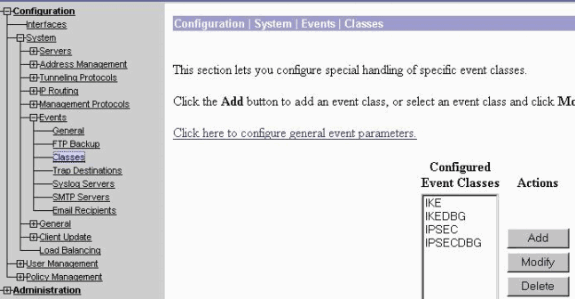
In order to view the current event log in memory, filterable by event class, severity, IP address, and so forth, choose Monitoring > Filterable Event log.
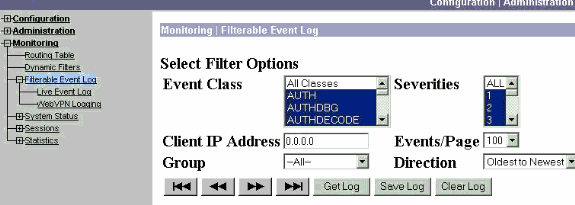
In order to view the statistics of the IPsec protocol, choose Monitoring > Statistics > IPSec. This window shows statistics for IPsec activity, including current IPsec tunnels, on the VPN Concentrator since it was last booted or reset. These statistics conform to the IETF draft for the IPsec Flow Monitoring MIB. The Monitoring > Sessions > Detail window also shows IPsec data.
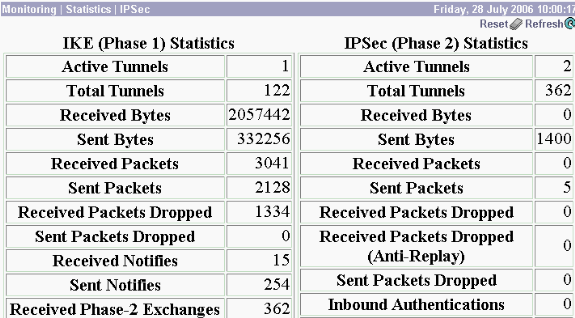
What Can Go Wrong
-
The Cisco IOS router gets stuck in the AG_INIT_EXCH state. While you troubleshoot, turn on IPsec and ISAKMP debugs with these commands:
-
debug crypto ipsec
-
debug crypto isakmp
-
debug crypto ezvpn
On the Cisco IOS router, you see this:
5d16h: ISAKMP (0:9): beginning Aggressive Mode exchange 5d16h: ISAKMP (0:9): sending packet to 10.48.66.115 (I) AG_INIT_EXCH 5d16h: ISAKMP (0:9): retransmitting phase 1 AG_INIT_EXCH... 5d16h: ISAKMP (0:9): incrementing error counter on sa: retransmit phase 1 5d16h: ISAKMP (0:9): retransmitting phase 1 AG_INIT_EXCH 5d16h: ISAKMP (0:9): sending packet to 10.48.66.115 (I) AG_INIT_EXCH 5d16h: ISAKMP (0:9): retransmitting phase 1 AG_INIT_EXCH... 5d16h: ISAKMP (0:9): incrementing error counter on sa: retransmit phase 1 5d16h: ISAKMP (0:9): retransmitting phase 1 AG_INIT_EXCH 5d16h: ISAKMP (0:9): sending packet to 10.48.66.115 (I) AG_INIT_EXCH 5d16h: ISAKMP (0:9): retransmitting phase 1 AG_INIT_EXCH... 5d16h: ISAKMP (0:9): incrementing error counter on sa: retransmit phase 1 5d16h: ISAKMP (0:9): retransmitting phase 1 AG_INIT_EXCH 5d16h: ISAKMP (0:9): sending packet to 10.48.66.115 (I) AG_INIT_EXCH
On the VPN 3000 Concentrator, Xauth is required. However, the selected proposal does not support Xauth. Verify that the internal authentication for Xauth is specified. Enable internal authentication and ensure that the IKE proposals have the authentication mode set to Preshared Keys (Xauth), as in the previous screenshot. Click Modify in order to edit the proposal.
-
-
The password is incorrect.
You do not see the Invalid Password message on the Cisco IOS router. On the VPN Concentrator, you might see Received unexpected event EV_ACTIVATE_NEW_SA in state AM_TM_INIT_XAUTH.
Ensure your password is correct.
-
The username is incorrect.
On the Cisco IOS router you see a debug similar to this if you have the wrong password. On the VPN Concentrator you see Authentication rejected: Reason = User was not found.
Related Information
Revision History
| Revision | Publish Date | Comments |
|---|---|---|
1.0 |
12-Mar-2007 |
Initial Release |
Contact Cisco
- Open a Support Case

- (Requires a Cisco Service Contract)








 Feedback
Feedback